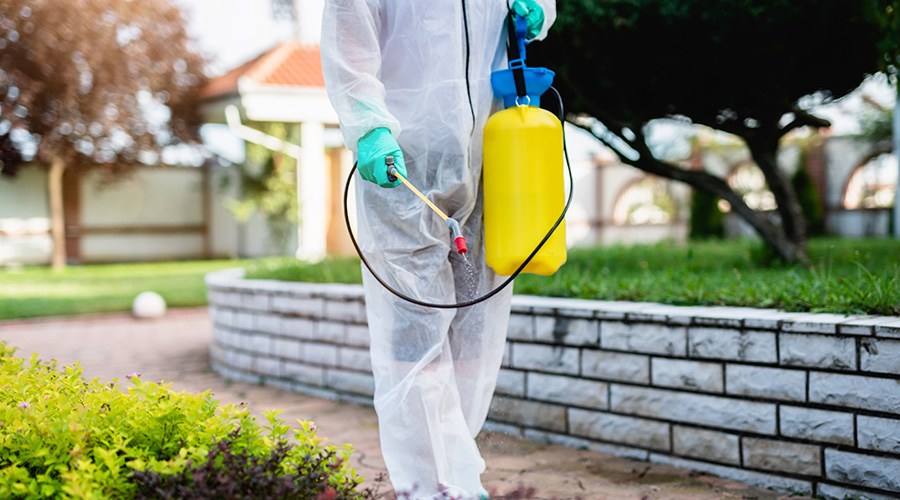
What to Know About Pesticide Use
There is a safe way to use pesticides during lawn care. July 29, 2024
By Mackenna Moralez, Associate Editor
One of the unique challenges of being a grounds manager is having to navigate the changing of seasons. While most people welcome summer and the warmer weather it brings, lawns need extra care to thrive in the heat and prevent unwanted pests.
Providing habitat for wildlife, while maintaining a safe and diverse landscape that is managed sustainably is a key part of a ground manager’s everyday duties. One way to achieve this feat is by using pesticides. FacilitiesNet recently spoke with Michael Gildea, Chevy Chase Club Director of Horticulture and Professional Grounds Management Society President-elect, on how managers can safely use pesticides on their lawns this summer.
FacilitiesNet: What types of pesticides are typically used? Do they serve specific purposes? Please explain.
Michael Gildea: Pesticides are classified based on what they control. The most common types used for grounds maintenance are insecticides, fungicides and herbicides. Pesticides are just one tool that is used to manage insect and disease issues in the landscape and are used only when necessary as part of an integrated pest management strategy (IPM). We take great pride in providing a diverse landscape with plants adapted to the specific conditions present. A diverse landscape not only has a wide range of plants, it also has a diverse population of insects and other organisms that keep pest populations in balance. If an application of a pesticide is necessary, we typically spot treat only the infested plant using the least toxic product labeled for that pest and follow the label exactly as written. Grounds managers take our role as stewards of the environment seriously.
FacilitiesNet: What is a typical policy on pesticide use? How often can they be applied?
Gildea: Pesticides are regulated by the US Department of Agriculture, OSHA, the EPA and state and local agencies. In Maryland, pesticides can only be applied by licensed individuals. Frequency and appropriate use and timing are all clearly stated on the pesticide label. Information on the label includes the signal word, i.e. Caution, Warning or Danger that indicates the acute toxicity of the product. The label also contains proper mixing and application timing along with all safety requirements and disposal methods. The label also contains all worker protection standards that must be followed to protect both the applicator and others. The label also ensures that non-targeted organisms such as birds, fish and mammals are not harmed by the application. The label is the law.
FacilitiesNet: How can a grounds manager ensure compliance with local, state, and federal regulations regarding pesticide use?
Gildea: In Maryland and other states applicators must hold a pesticide license or be supervised by licensed applicators to apply pesticides in commercial or public settings. In order to obtain the license, you must pass a test to prove your understanding of local, state and federal regulations and an understanding of pesticide labels. Recertification to maintain the license is required each year and includes knowing relevant changes or amendments to state and federal regulations and laws. Record keeping is an important part of pesticide applications and is required by law in Maryland. Pesticide application records include: the target pest, application rate and weather conditions along with when and where the pesticide was applied.
FacilitiesNet: What safety protocols should be followed when handling and applying pesticides?
Gildea: Safe practices are a key component of all grounds management tasks including the use of pesticides. The following is the protocol for applying pesticides:
- Read the Label: Thoroughly review the pesticide label before use. Understand precautions, first aid information, and proper application methods and frequency.
- Personal Protective Equipment (PPE): Wear the required protective clothing specified on the label. This typically includes long-sleeved shirts, long pants, non-absorbent gloves, rubber footwear, goggles, and a hat. Remove contact lenses before handling pesticides.
- No Smoking or Eating: Avoid smoking or eating while mixing or applying pesticides.
- Follow Directions: Use pesticides only for their intended purpose, in the specified amount, and under the recommended conditions. More is not better—it can harm you, others, or the environment.
- Mixing and Dilution: Always mix or dilute pesticides outdoors or in a well-ventilated area. Measure carefully and apply at the lowest rate possible for control.
- Keep Children and Pets Away: During application, keep children and pets away from treated areas. Follow the label’s re-entry time (or wait until the pesticide has dried).
- Dispose of Contaminated Clothing: If clothing becomes saturated with pesticide, dispose of it. Wash any exposed body parts with soap and water.
Mackenna Moralez is the associate editor for the facilities market.
Next
Read next on FacilitiesNet












